Vintage St. Pete: Founding fathers and famous names
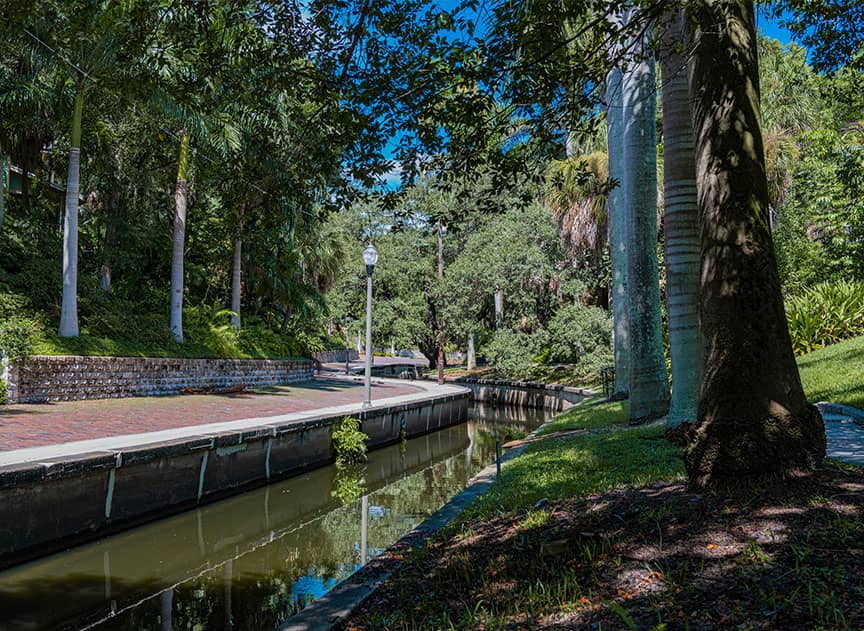
“What’s in a name?” William Shakespeare wrote in Romeo and Juliet, adding: “That which we call a rose by any other name would smell just as sweet.”
To expound, if St. Petersburg had been given the name Detroit, as was suggested by one of the city’s pioneers, would it still be the St. Petersburg we know and love?
The city was founded in 1888, and incorporated four years later, and many of the names so familiar to residents today were attached to real people, the majority of whom played important roles in the first half-century (and more) of local history.
These are names you’ll see as you cross a bridge, or walk through a park, stroll a neighborhood or ponder a monument. They all existed, and they all made marks on St. Pete so significant that those who came afterwards believed they should always be somewhere close by, if only in name and in memory.
The Courtney Campbell Causeway, crossing Old (northern) Tampa Bay and connecting Tampa and Clearwater, bears the name of Courtney W. Campbell, a member of the Florida State Road Board (now known as the Department of Transportation) in the 1940s. Campbell’s activism on behalf of the dilapidated Davis Causeway – named for construction boss Ben T. Davis, who owned it – was a major factor in getting the convenient over-water thoroughfare purchased by the state, repaired, beautified and brought up to speed. Thus, it was re-named in his honor (in 1948). Campbell was a resident of Clearwater Beach and served one term in the U.S. House, representing Florida’s 1st congressional district.
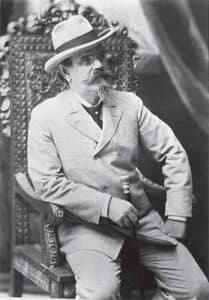
Demens. St. Petersburg Museum of History photo.
Demens Landing is named for Peter Demens, one of the most important individuals in the city’s early history and evolution. Born Pyotr Dementyev in 1849 into a wealthy family in Tver Oblast, Russia, he served in the Tzar’s military, and was in fact the sentry commander at the royal family’s Winter Palace. Exiled because of his political leanings in 1881, he arrived in Florida (he had a cousin living in Jacksonville) with $3,000, and changed his name to the American-sounding Peter Demens. Within four years he was operating a successful lumber business, and bought into the burgeoning Orange Belt Railway. Demens brought the end of the rail line to rural, western Hillsborough (now Pinellas) County; the settlement had no official name. According to legend, Demens and prominent landowner John C. Williams reportedly flipped a coin to decide who would name the new city. Williams would have called it Detroit, after his hometown, but Demens won the toss and the place became St. Petersburg – after the Russian City in which young Pyotr had spent his childhood. According to St. Petersburg Museum of History Director Rui Farias, the real story is far less colorful: Demens merely announced, publicly, that the terminus of the railroad would be “in St. Petersburg,” and Williams, who needed the Orange Belt business, simply let the Russian have his way.
Founded as Florida Presbyterian College in 1958, Eckerd College was re-named Eckerd College 14 years later, after drugstore magnate Jack Eckerd donated $12.5 million. Eckerd later tried, and failed, to get elected to the Florida Legislature, and to the governor’s office. Today, the 1,500-store-strong Eckerd Drugs chain is long gone, and Jack is remembered mostly for his philanthropy. Although the land for Clearwater’s premiere performing arts venue was donated to the city by the founders of the nearby Kapok Tree Inn, the venue was ultimately named for Jack Eckerd’s wife and fellow philanthropist, Ruth.
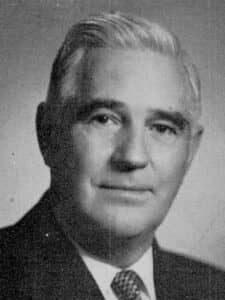
Frankland
The Howard Frankland (never “Franklin”) Bridge is named in honor of Tampa banker and transportation advocate W. Howard Frankland. He was a member of the State Road Board (later known as the Department of Transportation) when he worked to devise plans for a fourth Tampa Bay crossing to ease traffic loads on nearby Gandy Bridge, and – perhaps more pressing – to become the next link in Florida’s part of the federal Interstate highway system (for this reason, the U.S. government paid for 90 percent of the bridge’s $16 million cost). Since re-designed and altered several times (new construction is going on even now), the Howard Frankland Bridge opened Jan. 16, 1960. And right out of the gate there were gripes that it would not help much: “Traffic experts have predicted the mid-bay bridge will be dumping 75,000 cars a day into Pinellas in five years, most of it being funneled into St. Petersburg,” the Times newspaper wrote on opening day, “which has only 4th and 9th Streets to handle the flow right now.”
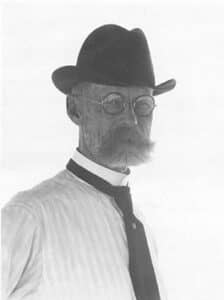
Gandy
Gandy Bridge (and Tampa’s Gandy Boulevard) are named for George “Dad” Gandy. A financier, businessman and practical engineer obsessed with transportation and its endless possibilities, Gandy came to St. Petersburg from Philadelphia in 1903 to build and operate the city’s trolley system. In 1915, Gandy set his considerable sights on constructing a traffic bridge over Tampa Bay. It took a while to raise capital for the privately-owned crossing, but Gandy in 1922 began selling stock in the project (cost: $1.9 million), and three-mile Gandy Bridge – at the time the longest over-water bridge in the world – was dedicated by the governor of Florida in 1924. Gandy Bridge, now owned by the state, was redesigned and rebuilt several times over the ensuing 98 years.
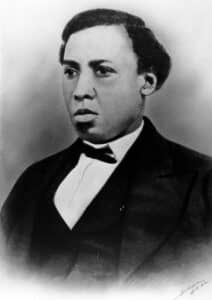
Gibbs
St. Petersburg’s Gibbs High School takes its name from Jonathan C. Gibbs, Florida’s first Black Secretary of State (1868-72) and Superintendent of Public Instruction (1873-74). During the country’s Reconstruction era, the Pennsylvania native was also a noted clergyman and missionary. Gibbs’ son Thomas was also a member of the Florida Congress, and he introduced legislation that would lead to the establishment of Florida A&M University.
The Sunshine Skyway Bridge is technically titled the Bob Graham Sunshine Skyway Bridge, and it’s so named in honor of Florida’s 38th governor. The first version of the bridge, which opened in 1954, was named by a local woman through a Chamber of Commerce-sponsored contest. Its identical twin (1971) was named for W.E. “Bill” Dean of the Florida Department of Transportation. That span was partially destroyed by an errant freighter in 1980, and it was Graham who pushed for the construction of an entirely new, state-of-the-art bridge, of French design, to replace both old spans. He was among the speechmakers at the dedication of the “new” Skyway in February 1987.
Boyd Hill Preserve, the city-owned 245-acre spread of woodlands, scrub and hiking trails near Lake Maggiore, was named for 1950s parks superintendent Boyd Hill. He was an advocate for leaving this massive wild area wild, for all to enjoy, and it opened – along with a small, primitive zoo – after his death in 1957. Read his story here.
There’s a life-sized statue (by sculptor Mark Aeling) of Tony Jannus on the St. Pete Pier. Jannus, whose name pops up often in St. Petersburg lore and legend, was the pilot who, in 1914, carried the first paying passenger on a scheduled flight (across Tampa Bay, as a matter of fact), thus becoming the de facto founder of commercial airline service. Read his story here.
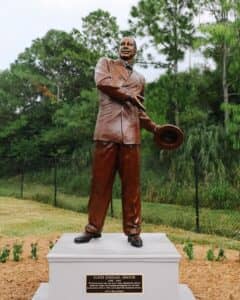
John Hair’s bronze statue of Elder Jordan Sr. stands outside the Manhattan Casino. Photo: City of St. Petersburg.
Jordan Park and Jordan Elementary School are so named to honor Elder Jordan Sr., the city’s most prominent and successful African-American businessman. Born into slavery in the mid 19th century, Jordan reportedly bought his freedom at the age of 15. Arriving in St. Petersburg from Columbia County in 1904, he and his sons built not only the Manhattan Casino (initially known as Jordan Dance Hall) but the Black residential community Jordan Park, for which he donated 24 acres. He advocated for and built Jordan Elementary School and – in those segregated times – fought for African-American access to Spa Beach, and a bus line for the Black community. Near the Casino a bronze statue of Jordan, by artist John Hair, was dedicated in 2020. Said Deputy Mayor Kanika Tomalin at the ceremony: “This great man, born into bondage but never enslaved, clearly his soul knew its purpose and refused to yield.”
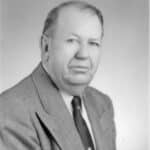
Dixie Hollins. St. Petersburg Museum of History photo.
“When you marriage Dixie Rebels with Confederate paraphernalia, that conjures up a connection to a past, and a racist past,” Principal Robert Florio, of St. Petersburg’s Dixie Hollins High School, said in 2020. The occasion was the official name-change to Hollins High School; the sports teams would henceforth be known as Royals, rather than Rebels, the name since the school opened in 1959. Namesake Dixie M. Hollins had, ironically, been a progressive when he was named the first Superintendent of Schools for Pinellas County in 1912. He argued for better education opportunities for Blacks. Hollins and his family once owned the St. Petersburg Printing Company and the Pasadena Country Club, as well as an expansive cattle ranch near Crystal River. And yes, “Dixie” was his given name.
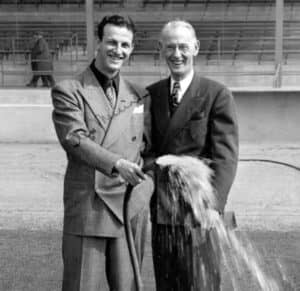
Stan Musial, left, and Al Lang, 1947. Florida Archives.
Al Lang Stadium was known for many years as Al Lang Field. Albert Fielding Lang was the mayor of St. Petersburg from 1916 to 1920, and as such he was part of the booster club of local politicians, developers and businessmen who worked to preserve the city’s waterfront park system. But Lang is best known as the man who brought spring training baseball to the city – first the St. Louis Browns, then the Philadelphia Phillies, and the Boston Braves, and then the New Yankees arrived in 1925, staying (with some short breaks) through 1961. Ruth, Gehrig, DiMaggio, Mantle … all the greats visited St. Petersburg to work out. On the bayfront, the St. Petersburg Athletic Park was demolished, the city erecting an entirely new stadium, bearing Lang’s name in honor of his service to the city, and to baseball. When Lang died in 1960, the St. Louis Cardinals were tenured at the ballpark each spring; the team stayed until the arrival of the Tampa Bay Devil Rays in 1998. The stadium was converted into a venue for soccer in 2011, to accommodate the Tampa Bay Rowdies.

Nelson Poynter
The Poynter Institute (for Media Studies), a world-renowned, nonprofit journalism school, was started in 1975 by Nelson Poynter, longtime owner, chairman and publisher of the St. Petersburg Times. The son of owner and publisher Paul Poynter, Nelson became an editor in the 1930s, and upon his father’s death in 1950 was named president and chief bottle-washer. Until his own passing in 1978, Poynter was virtually synonymous with the Times (it wouldn’t be re-named Tampa Bay Times until 2012). He was liberal and he was innovative; he was a powerfully political ally and a vitally vocal civic booster.

Roser
The Roser Park Historic District is named for Charles M. Roser, a developer who moved to St. Petersburg from his native Ohio in 1910. He’d been a confectioner and cookie-baker, and is credited – in some corners – with the creation of the Fig Newton (this has never been verified by Nabisco, which has been turning out Fig Newtons since 1898). The block retaining walls, brick streets, hexagon sidewalk pavers and granite curbstones that made his Roser Park development so unique are, for the most part, still there. However Roser made his fortune, he put it to good use in St. Pete, building (according to historicroserpark.org) the Palm and Poinsettia hotels, Mound Park Hospital, Mercy Hospital, the Roser Park School and other concerns.
Snell Isle (and Snell Arcade) bear the imprint of C. Perry Snell. Snell was a millionaire developer from Kentucky who bought his first piece of St. Petersburg – between 1st and 2nd Avenues NE, and between Beach Drive and 1st Street, in 1899. As a resident, he bought up acres of what is now known as Old Northeast, and filled a salty mangrove island to build – you guessed it – Snell Isle, still one of the most upscale neighborhoods in the city. Snell opened the city’s first golf course, the nine-hole the Coffee Pot Golf Club, in the early ‘20s (it was later renamed the Sunset Golf and Country Club, and remains today as part of the Vinoy Resort). As a contemporary of William Straub’s, he was heavily involved in the efforts to turn the entire bayfront into a series of waterfront parks; Snell donated the land between downtown and Coffee Pot Bayou to the city with the proviso it remained green and public.

Straub
North and South Straub Park honor William Straub, who historian Walter P. Fuller called “the greatest influence for the development of the community ever to appear on the scene.” Editor of the St. Petersburg Times for 38 years (he bought the paper in 1901 for $1,300), the Dakota Territory native was a vocal and tireless crusader for better roads, schools and government, and was at the head of the campaign to keep the city’s waterfront parks undeveloped and publicly owned. Straub sold majority ownership of the newspaper to Paul Poynter in 1912, but continued as editor until his death in 1939.
Albert Whitted Airport bears the name of Albert Whitted, a pioneering aviator who flew sightseeing trips over Tampa Bay in the 1920s. During World War I, Whitted had been a first lieutenant in the U.S. Army Aviation Corps. Read his story here.

Williams
Williams Park is named for John Constantine Williams. A wealthy landowner from Michigan who relocated to Florida for his health, Williams purchased a good deal of what would become St. Petersburg, and he traded a portion of his holdings to train man Peter Demens, so that the Orange Belt Railway would extend to the area in the late 1890s (the population at the time was less than 100). St. Petersburg was incorporated in 1892.


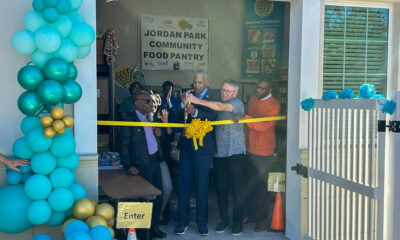

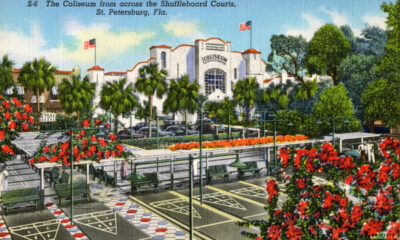



laura Salamido
November 28, 2022at6:55 pm
A great historical overview of these places and people, it’s too bad there are not really any women represented in our City like this…
Matthew Goodner
November 28, 2022at10:46 am
What an interesting read. Dang that was good. Thanks.
Jane Devoe
November 27, 2022at8:36 am
Thanks, Bill! I’ve been here since 1970 and didn’t know most of these local historical figures.
Scott Hamilton
November 27, 2022at6:58 am
Very interesting article. Thanks
KAREN J. DOUGLAS
November 26, 2022at5:05 pm
Mr DeYoung, you have done it again. I thoroughly enjoyed every word of this article. Shared it with friends, too.
Thank You